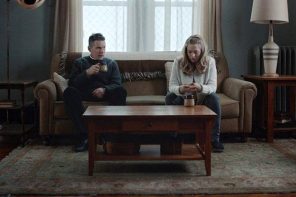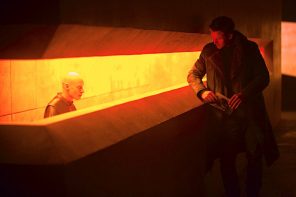In the beginning were the stars, the cosmos ordered and still.
Like every other film announcing its mytho-logic from the get-go, the first thing we see in Cloud Atlas is a shot of the milky heavens above, which then tilts down toward life in the mortal realm below. We then meet an old man sitting by a fire, face marked by the ages and rites of etching and inking, telling a cryptic story of struggle and survival.
Similar up-and-down cinematographic cosmologies have been used in productions as diverse as David Lynch’s Disney-distributed pilgrimage tale The Straight Story, Ron Fricke’s experimental-spiritual documentary Baraka, and Star Wars; macro-cosm meets micro-cosm with characters placed in a grand narrative where clashings of cosmos and chaos commence.
Cloud Atlas is 172 minutes long, directed by three people (Lana Wachowski, Thomas Tykwer, and Andy Wachowski), acted by A-listers who each play multiple roles through the twists of six plotlines, and with a stated budget of $100 million—the film is bound to frustrate, confuse, and amuse. Richard Brody at The New Yorker finds it audio-visually banal, while Zack Beauchamp writes an intellectually sympathetic essay at Think Progress; A.O. Scott at the New York Times offers, as usual, a solid review.
But here I want to home in on some curious mystical and mythical melodies of this six-part narrative.
The End Becomes the Beginning
Mythological beginnings unfold throughout Cloud Atlas. Stories of old are spoken, sacred texts revered and read, past prophets and future messianic revolutionaries virtually realized, while hints are dropped about an undisclosed event (“The Fall”) that occurred sometime in the past—which is the film audience’s future. Six stories pile up, unravel, and recombine—and the end becomes the beginning in reverse as camera tilts back up, from campfire stories to stars, signaling both finale and repetition. Be kind. Rewind.
Gimmicky they may be, I’m always a sucker for the structured synchronic interweavings of films like this. Pulp Fiction, Before the Rain, Magnolia, and Tykwer’s own Run Lola Run play with repetition and simultaneity, inserting tags into the mise-en-scene that provide clues to the interconnections. Sometimes it’s for fun or simple coherence, while other times it is making a deeper point, as it does in Cloud Atlas.
Critics of the film have noted that the individual narratives are not compelling unto themselves. Perhaps. But the point is that it’s all in the in-between, the movements and connections across people, places, things, and times. Characters, variously, are shot through the head, forced off bridges, read stories, and fall over balconies.
Beyond the fact that the same actions are replayed in different scenarios and the same actors play multiple parts in various storylines, interconnection is primarily achieved through simple jump cuts and parallel editing back and forth in time and space. While it may be confusing to keep all the stories and voiceovers straight as scenes toggle, the carefully crafted color palettes, props, and costumes make the divisions quickly comprehensible.
The 1973 San Francisco story looks not unlike the 1970s TV series The Streets of San Francisco, while the 2114 sets are a combination of Blade Runner and the Matrix trilogy, and the 1849 set is a bit Master and Commander with some Amistad thrown in. The mixing of times and stories meshes with a mixing of production styles, all overlaid with a mixing of myths.
As all myths are already mashups, Cloud Atlas rewrites the mythologies large, from South Asian religious mythical traditions of samsara (the cycle of birth, death, and rebirth) and moksha (liberation from the cycle) to contemporary popular cultural products, borrowing and rephrasing from a repertoire of cultural symbols.
The Trans-Mediation of Souls
Perhaps the most fascinating mythical mashup is the so-called metempsychosis, the transmigration of characters’ souls across generation and gender, race, and place. In the film this is pulled off through the same actors playing different roles, while viewers squint to read the eyes of the character to figure out who is playing whom.
Yet what Cloud Atlas ultimately presents is the trans-mediation of soul. Souls are ultimately passed on via technological communications media.
A lawyer in the nineteenth century named Adam Ewing (Jim Sturgess) is slowly being poisoned by a doctor (Jim Broadbent) who’s really thieving for his gold. The lawyer keeps a journal, a fact we know because the 1936 story has music composer Robert Frobisher (Ben Whishaw) reading the published version of The Pacific Journal of Adam Ewing, even though the book is ripped in half and he cannot finish it—the second half is revealed to be in place balancing a table. 1973’s scenario has the journalist Luisa Rey (Halle Berry) searching for Frobisher’s difficult to find Cloud Atlas Sextet in record shops in San Francisco, while her young neighbor, Javier Gomez, helps out. In the 2012 story, Timothy Cavendish (Jim Broadbent) is a book publisher who is reading a manuscript by “Javier Gomez” on the detective fiction of “Luisa Rey.” 2114 gives us a “Fabricant” (a genetically constructed human made as a servant/slave caste) called “Sonmi-451” (Doona Bae) whose first taste of freedom is a short video clip of a film called The Ghastly Ordeal of Timothy Cavendish. And finally, the post-apocalyptic island dwellers read from the sacred scriptures of the old prophet Sonmi-451. It’s all sandwiched by the old man by the fire, Zachry (Tom Hanks), who tells tales of the past.
All this is furthered (in a meta-mediated way) as David Mitchell’s 2004 novel, Cloud Atlas, is itself now re-released with an afterword by Mitchell reflecting on the process of this screen adaptation, this trans-media movement. The author gives his wholehearted thumbs up to the process, bestowing blessings on the changes and alterations made, but with a curious caveat: “the fact soon sinks in that you’ve morphed from being your novel’s monotheistic Creator to the guy who happened to write the original novel.”
Unlike the film, which jumps across stories, the book starts with the oldest story (1837), proceeds chronologically to the post-apocalyptic center, and then backwards in time again so that the final words are from Ewing’s journals—the man named Adam. The narrator/journaler ends the 500-page book with a line repeated a bit earlier in the film. In response to his life being “no more than one drop in a limitless ocean,” Adam says, “Yet what is any ocean but a multitude of drops?”
The mystical thrust of the book and film are summed up in that statement. What becomes interesting is the ways that different media portray such interconnection. With words, but also with images and sounds, we begin again, are born again, and again, in and through our media.
The great paradox of religious tradition is that the mystical “im-mediate” experience is always reliant on the medium that takes us there. Transcendence is achieved by going more deeply into material reality, not away from it. Each cycling through time entails an inspiration from one generation to the next.
From orality to literacy, writing to typing, and on to interplanetary virtual communications, Cloud Atlas means to mediate spirit. Social media is soul media. No longer embodied, but em-mediated. The self transformed into typed characters, bits and bytes, radio waves, frequencies unheard and previously unhearable, going through walls and trees, breaching skin and skulls.



